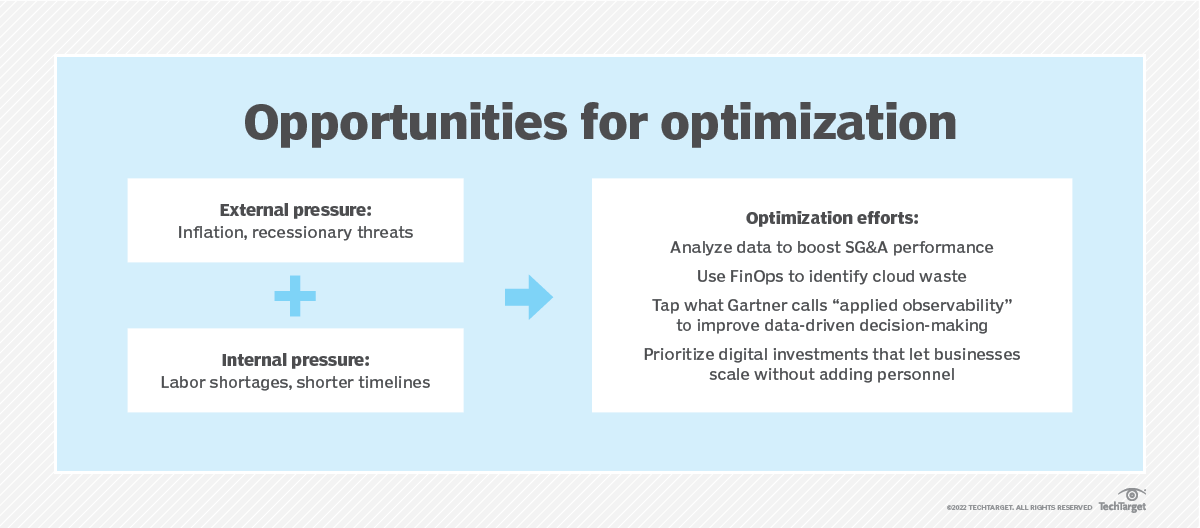Published by
The market research firm said enterprise IT spending will endure in a tough economy, but noted an emphasis on optimization, productivity gains and rooting out inefficiencies.
IT spending will expand 5.1% in 2023 despite economic uncertainty, but CIOs and other C-level executives will view investments through an optimization lens and pursue digital initiatives with more caution.
Those are some of the takeaways from a series of Gartner reports published this week during the market research firm’s annual IT Symposium/Xpo event. The studies highlight the continued resilience of IT investment, underscoring the rise of digital businesses and their reliance on technology. They also point to the importance of optimization as businesses look to get the most out of previous IT expenditures, root out inefficiencies and scale operations without adding hard-to-find technical personnel.
According to Gartner, IT spending will reach $4.6 trillion worldwide next year, a 5.1% increase compared with 2022. Signs of persistent investment come amid a cooling economy. U.S. GDP declined in the first quarter and Q2, with the government set to release an advance estimate of Q3 numbers next week.
Gartner’s latest forecast, however, suggested tech spending will run counter to the overall economic trend.
“At this point, enterprise IT spending is recession-proof,” said John-David Lovelock, vice president analyst at Gartner.
Lovelock said enterprises don’t have the “opportunity to cut IT in the way we did back in 2001.” That was before widespread digitalization, when IT was still largely a behind-the-scenes operation.
“Our spending is different,” Lovelock said. “IT has gone from back of house to front of house, and often revenue producing.”
A focus on optimization
Gartner’s annual global CIO survey, meanwhile, noted that CIOs’ future technology plans will “remain focused on optimization rather than growth.” The survey, which polled more than 2,000 CIOs, found that cyber and information security, business intelligence/data analytics, and cloud platforms were the top areas earmarked for increased investment in 2023. While half or more of the CIOs identified those fields, other technologies ranked lower on the list — 32% of CIOs cited AI as a top priority, and 24% cited hyperautomation.
“The pixie-dust era of digital being a fix for all ills, by completely transforming the enterprise, may be drawing to a close,” said Andy Rowsell-Jones, vice president analyst at Gartner and co-author of the company’s “CIO Agenda” report. A “genuine desire for productivity improvement,” along with a commitment to drive out inefficiencies, is poised to replace that phase, he added.
In the business intelligence/data analytics context, the optimization task is broader than IT, Rowsell-Jones said. Businesses can strive to make better use of their data, but such efforts involve finding opportunities for improvement within selling, general and administrative costs, he noted.
In another optimization play, organizations might look to more closely examine their cloud expenditures, investing in tools for doing so. The CIO survey did not cover FinOps, a framework for managing Opex costs, but Rowsell-Jones said it could play a role. “It is reasonable to speculate that FinOps tools will be among the cloud tools management will be using to hunt for waste in their organizations,” he said.
In addition, economic pressures are likely to “once again drive the spend optimization behaviors we last saw during the global financial crisis,” Rowsell-Jones noted. Those behaviors include “finding and eliminating shelfware as a service, even if that shelfware is now in the cloud.”
Some cost-cutting and operations efficiency initiatives are originating outside the IT department — and ending up on CIOs’ digital transformation project lists, Lovelock noted. In Gartner’s July survey of CFOs, two-thirds of the respondents said they were ready to increase investment in digital acceleration efforts. Those projects included a lot of work external to the CIO’s office, with finance, supply chain, marketing and HR among the departments contributing, Lovelock said.

Optimization covers a wide spectrum of activities. Image via TechTarget.com
Second-decade transformation
Industry consultants have also observed the shift in IT thinking toward optimization. Peter Klayman, vice president of business strategy at digital experience consultancy Bottle Rocket, said the current phase stems from the sharp rise in digital investments.
“If you think about what’s happened over the last three years in digital, we saw a massive spike in spend associated with digital solutions,” Klayman said. That’s because businesses wanted to seize the opportunity to meet customers digitally first, he noted. And some needed to spend just to remain relevant.
But periods of great capital influx create operational efficiencies, Klayman said.
“When we think about optimization on behalf of our clients, or even our own business, we’re thinking about second-decade digital transformation,” Klayman said. “We all have apps now, we all have websites, we all have some element of a cloud strategy. But are these optimized?”
Entering the new phase of inflationary and recessionary pressure, “it makes sense for IT organizations to say, ‘Let’s focus on what we know and what needs to work well, rather than going after new capabilities,'” Klayman said.
In this emerging stage of transformation, data analytics — cited by 55% of Gartner’s CIO survey respondents — ranks among the top priorities for CIOs. Saveen Mundarath, chief data analytics officer at NTT Data, a digital business and IT services provider based in Plano, Texas, said he’s seeing customer demand rise for that technology. NTT Data earlier this month agreed to acquire Aspirent, an Atlanta company that will add to its roster of data specialists.
“Being a digital, data-driven organization is now the baseline in achieving competitive advantage in the marketplace,” Mundarath said. “Data is in every aspect of the business, and analytics is foundational in informing sound business decisions and to innovate and optimize every value chain of the business.”
For customers, having strong data and analytics services in place becomes “an essential part of weathering an economic downturn,” he added.
“The average business has more data than they know what to do with,” Klayman said. “I feel the real challenge when it comes to business intelligence and data analytics is not about collecting data, but rather about being able to effectively use data to drive useful insights and actionable change.”
Other priorities include improving customer or citizen experience, which 45% of the CIOs in Gartner’s survey identified as a leading investment focus over the past two years.
Klayman suggested customer experience investments dovetail with tighter economic times. “In a recessionary world, discretionary spending drops — and when discretionary spending drops, you have to fight harder for the same customer dollars.”
Share:
Categories
tags
Related Posts

AI and the Future of Restaurant Hospitality

The Value of Agency Project Managers


